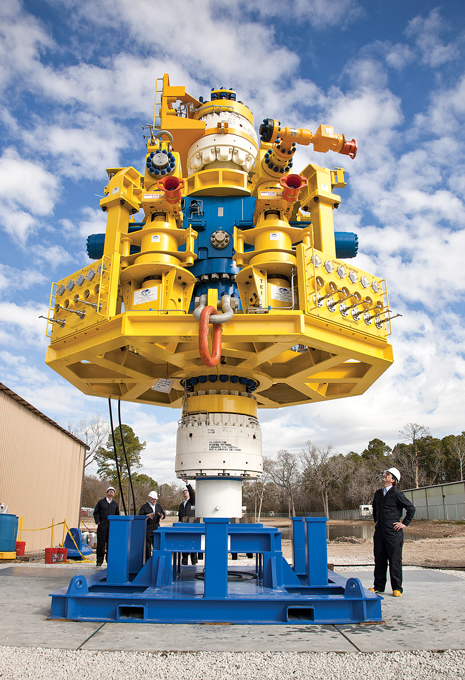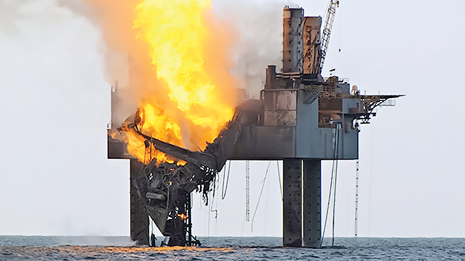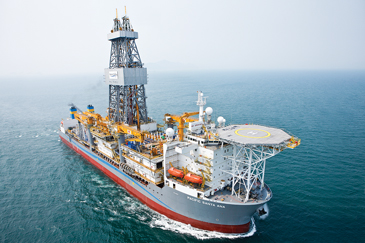DAVID BLACKMON, Contributing Editor
 |
| BSEE’s notice NTL 2010-N10 required deepwater operators to deploy subsea containment resources, resulting in the development of several capping stacks, including this Marine Well Containment System. |
|
Few elements of oil and natural gas development in the United States have experienced a seemingly endless teeter-tottering series of ups and downs as have plans for leasing in the federally-owned waters of the Outer Continental Shelf (OCS). Beginning in 1981, when Congress passed the first of many annual moratoria on new OCS development, subsequent congresses and presidents have struggled to arrive at exactly the right policy approach to accessing and producing the rich energy resources that lie beneath these waters.
OCS POLICY SHIFTS
Here is a brief timeline of some of the major policy shifts that have taken place since 1981:
- 1990. President George H.W. Bush implements the first executive order, creating a moratorium on OCS development along the nation’s Pacific and Atlantic coasts;
- 1993-2000. Throughout Bill Clinton presidency, the Department of Interior and key congressional committees regularly debated whether or not to spend the funds necessary to update a 1970s-era inventory of potential OCS oil and natural gas reserves. This inventory remains in adequate and dated;
- July 2008. President George W. Bush, in response to rising gasoline prices, lifts his father’s executive order, denying OCS leasing along the Pacific and Atlantic coasts. A few weeks later, he announces the start of a new OCS five-year planning process that would provide for lease sales in those parts of the OCS;
- October 2008. Congress follows President Bush’s example, lifting its own ban on OCS leasing;
- January 2009: A few days before President Obama assumes office, Bush’s Interior Department issues a draft five-year plan. The plan includes proposed lease sales off both the Pacific and Atlantic coasts, as well as the Gulf of Mexico and Alaska. This plan will be very short-lived;
- February 2009. Incoming Interior Secretary Ken Salazar announces an indefinite delay in the Bush five-year plan. In September of that year, he states that DOI may not complete a new five-year plan until 2012;
- January 2010. DOI announces the cancellation of a scheduled Virginia offshore lease sale that had been planned to take place in November 2011;
- December 2010. The Obama Administration effectively reinstates the ban on new offshore leasing along the Pacific and Atlantic coasts, the Eastern Gulf of Mexico, and major portions of offshore Alaska;
- November 2011. The Obama Administration announces a new draft 2012-2017 OCS leasing plan, that limits lease sales for oil and gas development to the Western Gulf of Mexico and portions of offshore Alaska, effectively returning allowed leasing back in time to 1981.
So, access to oil and gas leasing and development in the OCS essentially came full circle over a period of 30 years.
NEW REGS AFTER DEEPWATER HORIZON
The above timeline above doesn’t mention the 6-month moratorium on all deepwater offshore drilling imposed by the Obama Administration in the Gulf of Mexico following the Deepwater Horizon blowout and spill that took place in April 2010. Though not formally a part of that moratorium, issuance of shallow-water permits to drill was also subject to a de facto moratorium during that period of time. That moratorium was technically lifted in October 2010, but the pace of issuance of new permits to drill and other regulatory approvals related to OCS development has been slow to recover.
 |
| Lessons learned from the Deepwater Horizon incident may have helped early evacuation of the crew from the Hercules 265 rig, after a blowout in late July 2013. BSEE is monitoring activities associated with sealing of the well and the possible drilling of a relief well. Photo courtesy of U.S. Coast Guard. |
|
The aftermath of the Deepwater Horizon event also served as a catalyst for DOI’s then-named Bureau of Ocean Energy Management, Regulation and Enforcement (BOEMRE) to issue a series of Notices to Lessees and Operators (NTLs) and permitting requirements that have had the effect of dramatically increasing regulatory oversight of OCS oil and gas development operations. The timeline for these notices:
- May 30, 2010 – NTL 2010-N04. Implemented the six-month moratorium, that required OCS operators to cease all drilling of deepwater wells, and prohibited the spudding of any new deepwater wells during this time period;
- June 6, 2010 – NTL 2010-N05. Required operators to submit a statement, signed by the CEO of the company, certifying that the operator is in compliance with all relevant operating regulations: “By signing this certification, I certify in my capacity as authorized official that the statements herein are true and complete to the best of my knowledge. I understand that the submission of false statements to the United States is a criminal offense under 18 U.S.C. Section 1001.” NTL 2010-N05 also required the conduct of additional inspection, maintenance and testing. This NTL was rejected by a federal court on Oct. 19, 2010;
- June 18, 2010 – NTL 2010-N06. Required deepwater operators to demonstrate their preparedness for a well blowout and worst-case discharge (WCD) of oil and/or natural gas, and to include that information in their initial prospect Exploration Plan (EP) and a Development Operations Coordination Document (DOCD). It required operators to recalculate the WCD for existing plans, which BOEMRE would then verify and inform the operator, if it agreed with the calculation. This required the re-submittal of many pre-existing EPs and DOCDs;
- Aug. 16, 2010 – Revision of NEPA Reviews. BOEMRE Director Michael Bromwich instructed his staff to stop the use of categorical exclusions under the National Environmental Policy Act (NEPA) in the approval process for deepwater drilling activities indefinitely. The categorical exclusion process was established years before as a means of reducing the volume of unnecessary paperwork and delay associated with NEPA compliance;
- Oct. 12, 2010 – NTL 2010-N10. Required deepwater operators to submit information, demonstrating that it has access to and can deploy subsea blowout containment resources significant enough to promptly respond to a deepwater blowout or other well control event;
- Nov. 15, 2010 – SEMS Regulation: Required all OCS operators to implement a Safety and Environmental Management System (SEMS) designed to reduce human and organizational errors, deemed to be the root cause of work-related accidents and offshore spills. This rule was beefed up in April 2013 with the SEMS II addition of a provision that requires audits to be conducted by accredited third parties.
Any given regulatory action or new requirements, issued via NTLs, inevitably create a period of time in which delays come about as operators and the regulatory agencies adjust their processes and systems to accommodate the new mandates. In the normal course of business, months will go by between such actions, giving operators and regulators time to absorb the new requirements, and time delays are minimized.
But the Deepwater Horizon event was an extraordinary event, one that the federal government felt required an extraordinary response, which manifested itself in this series of new mandates being issued over a six-month period. As one would expect, the period of adjustment and expanded delays in regulatory permitting and approvals resulting from such a rapid issuance of new requirements has been extraordinary, and is still being felt to this day.
EFFECTS OF NEW REGULATIONS
One important factor that has made the Gulf of Mexico such a successful venue for oil and gas development efforts was the predictability of the regulatory and legal environment in the United States. After the government’s response to the Deepwater Horizon event, that predictability was lost for an extended period of time.
One result of that loss of predictability was that many operators reassigned drilling rigs that had been contracted for work in the Gulf of Mexico, and they have been slow to return. Such rigs are extremely expensive to secure, and operators simply could not afford to have them sit idle during the six-month moratorium and the shaking-out period that followed. As a result, the deepwater rig count had fallen below 30 in 2011, but had risen to 40 earlier this year. Some analysts are predicting that count could more than double by 2017, as companies become increasingly efficient at obtaining the regulatory approvals necessary to do their business.
One challenging impact of the shutdown of drilling in the Gulf of Mexico has been the creation of a manpower shortage, and increased labor costs for operators. Bruce Peterson, Senior Partner at Korn/Ferry International, told the Houston Business Journal earlier this year that, as those rigs moved to international locations “The employees went with that equipment, and they started experiencing higher pay in different areas of the world. To come back to the Gulf of Mexico, they’d be looking at less compensation. To get them back, companies are going to have to match that compensation, and that causes the cost to go up.”
Mr. Peterson pointed out that wages for offshore rig workers in Africa can be 25% to 50% higher than for similar workers in the Gulf. “It’s the perfect storm for employees because of all the new activity that comes with new rigs in other basins and the Gulf of Mexico coming back,” he said.
Another impact of this new regulatory environment is that operators must begin their planning processes much further in advance than was previously necessary. It takes about twice as long now to obtain a permit to drill in the deepwater than it did in 2009, but before an operator can even apply for such a permit, it must obtain regulatory approval for an initial Exploration Plan (EP) for the prospect, as well as a Development Operations Coordination Document (DOCD).
Per the BOEM website, an EP “describes all exploration activities planned by an operator for a specific lease(s), the timing of these activities, information concerning drilling vessels, the location of each well, and an analysis of both offshore and onshore impacts that may occur as a result of the plan’s implementation.”
The DOCD “is a plan that describes development and production activities proposed by an operator for a lease or group of leases. The description includes the timing of these activities, information concerning drilling vessels, the location of each proposed well or production platform or other structure, and an analysis of both offshore and onshore impacts that may occur as a result of the plan’s implementation.”
Prior to the Deepwater Horizon event, in the second half of 2009 through March 2010, the average approval time for a new EP was 52 days, and 77 days for a new DOCD. For EPs and DOCDs submitted in the second half of 2010, those timelines for approval were dramatically lengthened, to 234 days and 216 days, respectively. Such long time delays not only increase costs to operators in a province in which costs are already extremely high, they also increase the likelihood that operators will need to file Revised and Supplemental plans as facts and situational changes take place over time.
To the government’s credit, approval times for EPs have gone down significantly since 2010, to an average of 144 days in 2011 and 121 days in 2012. Those time periods are still more than twice the average experienced by operators prior to the Deepwater Horizon event, but some operators are optimistic that they will continue to lessen as operators and regulators alike become more efficient at functioning in the new regulatory environment.
However, time frames for approval of DOCDs have gone in the opposite direction since 2010, rising to an average of 230 days in 2011 and 235 in 2012. One factor that seems to be a part of the problem here was the decision to divide the BOEMRE into two separate entities on Oct. 1 2011: the Bureau of Ocean Energy Management (BOEM) and the Bureau of Safety and Environmental Enforcement (BSEE).
The two new bureaus were created to serve separate functions, per the official BOEM website:
- BOEM is responsible for managing development of the nation’s offshore resources in an environmentally and economically responsible way. Functions include: Leasing, Plan Administration, Environmental Studies, National Environmental Policy Act (NEPA) Analysis, Resource Evaluation, Economic Analysis and the Renewable Energy Program.
- BSEE was created to enforce safety and environmental regulations. Functions include: All field operations, including Permitting and Research, Inspections, Offshore Regulatory Programs, Oil Spill Response, and newly formed Training and Environmental Compliance functions.
However, both agencies must separately approve EPs and DOCDs, and the splitting of BOEMRE into two organizations without increased funding from congress inevitably created staffing shortages at both of the bureaus in some key areas. Those staffing issues, combined with the difficulty in adjusting to new permitting, planning and regulatory requirements, have, without question, contributed to these lengthened approval periods.
As with any other aspect of the oil and gas industry, time is money, and these kinds of regulatory and permitting delays have significantly raised the costs of developing the nation’s deepwater resources. Presumably, staffing issues at the companies and regulatory bureaus will be worked out over time, but it is doubtful that approval timelines will ever return to their pre-2010 time frames.
BIG CONCERN: BONDING
One major concern, currently on OCS operators’ minds, is the government plan to revise bonding requirements for OCS projects. Under existing regulations, lessees are required to prove that they possess the financial wherewithal to decommission a given location that is no longer subject to the terms of a federal lease, either due to lease termination or cessation of production. Upon approval of an EP, the lessee must then provide additional financial surety to cover estimates of added liability that would be created through the plan.
 |
| The lure of giant discoveries is steadily raising the deepwater Gulf of Mexico rig count, despite increasing requirements for regulatory compliance. Photo courtesy of Pacific Drilling. |
|
Again, both BOEM and BSEE are involved in the governance and enforcement of these requirements, with BSEE maintaining a database of cost estimates that the BOEM then refers to when determining the amount of financial assurance that may be required from each operator.
Lessees currently have several means of providing this financial assurance. They can:
- Post a surety bond that covers the amount of calculated liability;
- Apply for exemption from bonding by supplying BOEM with audited financial statements that demonstrate the financial ability to cover calculated liabilities. (Currently, if one partner is exempt from bonding, BOEM does not require other partners to post bonds);
- Provide treasury bills to the BOEM covering the calculated liabilities; or
- Obtain a third party indemnity guarantee—normally from a parent company or major investor.
These bonding requirements are now subject to an ongoing review. One change, under consideration, would eliminate the current provision, that allows one exempt partner to exempt other partners in the leases. And the government is also currently in the process of revising the cost estimate matrix in ways that could dramatically increase estimates of liability, especially for deepwater development projects. Companies with existing bonds are already beginning to receive notices requiring them to increase sureties over and above what they already have in place.
It remains to be seen how broad the impacts of the new requirements will be, but increasing costs always carry with them the potential of rendering some projects uneconomic to drill.
CONCLUSION
The OCS has always been a challenging, expensive and complex province in which to explore for oil and natural gas, never more so than it has currently become, especially for deepwater projects. Gone are the days when the Clinton Administration and Congress enacted the Deepwater Royalty Relief program, which helped provide the impetus and capital for companies to move into the deepwater in the mid-1990s. And yet, the potential prize in the deepwater continues in many instances to outweigh the risks, regulatory complexities and costs, as evidenced by the steady recovery in the deepwater rig count in the last couple of years.
The oil and natural gas industry has consistently proven over the last 160 years the ability to adapt its business practices, processes and technologies to accommodate a constantly changing regulatory environment. The evidence thus far is that it is continuing to do so in this brave new world of dramatically increased OCS regulatory scrutiny. 
|





